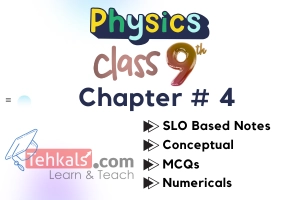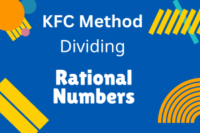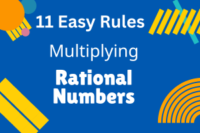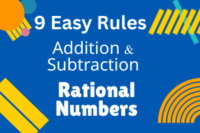Class 9 Physics Chapter 3
Published: 19 Oct 2023
Class 9 Physics Chapter 3 is about Dynamics”. This article includes topics such as Definition of Dynamics, Force, Newton’s Law of Motion, Inertia, Newton’s First Law of Motion, Newton’s Second Law of Motion, Newton’s Third Law of Motion, Mass, Weight, Linear Momentum, Force and Change in Momentum, Isolated System, Change of Momentum and Collison’s, Change of Momentum and Expulsive Forces, Rocket Propulsion and Thrust, Friction, Normal Force, Types of Frictional Forces, Static Friction, Kinetic Friction, Coefficient Friction, Advantages of Friction, Disadvantages of Friction, Rolling Friction, Methods of Reducing Friction, Tension, Uniform Circular Motion, Centripetal Acceleration and Centripetal Force.
Class 9 Physics Chapter 3 Notes
Dynamics Notes
Class 9 Physics Chapter 3 SLO Notes
Class 9 Physics Chapter 3 MCQs
Dynamics
1 The branch of mechanics which deals with the study of motion by analyzing the cause of motion is called(a) Kinematics
(b) Dynamics
(c) Optics
(d) Thermodynamics
Show Answer
Dynamics
Force
2 A push or a pull on an object is called(a) Work
(b) Energy
(c) Force
(d) Momentum
Show Answer
Force
3 Force is a …………. quantity.
(a) Scalar
(b) Vector
(c) Tensor
(d) None of these
Show Answer
Vector
Vector4 What is the unit of force in the SI system?
(a) Joule
(b) Pascal
(c) Newton
(d) Watt
Show Answer
Newton
5 What is the symbol of force?
(a) F
(b) M
(c) A
(d) V
Show Answer
F
6 Force is a vector quantity. What does this mean?
(a) It has magnitude only
(b) It has direction only
(c) It has both magnitude and direction
(d) It has neither magnitude nor direction
Show Answer
It has both magnitude and direction
7 How can Newton $ (N) $ be expressed in terms of fundamental units?
(a) $ Nm^2/kg $
(b) $ kg/m^2 $
(c) $ kgm/s^2 $
(d) $ N/kg $
Show Answer
$ kgm/s^2 $
8 Which of the following is an example of a contact force?
(a) Gravitational force
(b) Magnetic force
(c) Frictional force
(d) Electric force
Show Answer
Frictional force
9 Which of the following is an example of a non-contact force?
(a) Frictional force
(b) Magnetic force
(c) Normal force
(d) Applied force
Show Answer
Magnetic force
10 In which book did Newton publish his laws of motion?
(a) Physics
(b) Elements
(c) Optics
(d) Philosophiæ Naturalis Principia Mathematica
Show Answer
Philosophiæ Naturalis Principia Mathematica
To Download Complete Notes of Physics Notes 9 Class, Click on the given link.
Newton’s Law of Motion
11 Law of motion was presented by:(a) Einstein
(b) Newton
(c) Galileo
(d) None of these
Show Answer
Newton
Newton’s First Law of Motion
Inertia
12 Newton’s first law of motion is also known as the law of:(a) Acceleration
(b) Force and motion
(c) Inertia
(d) Interaction
Show Answer
Inertia
13 The property of a body due to which it retain its state is called
(a) Inertia
(b) Force
(c) Work
(d) Energy
Show Answer
Inertia
14 A physical quantity which moves or tends to move, stops or tends to stop a moving object is called
(a) Inertia
(b) Force
(c) Momentum
(d) Work
Show Answer
Force
15 The quantitative measure of inertia is called
(a) Force
(b) Inertia
(c) Mass
(d) Time
Show Answer
Mass
16 Law of inertia is actually the …………. Law of motion
(a) $ 1^{st} $
(b) $ 2^{nd} $
(c) $ 3^{rd} $
(d) None of these
Show Answer
$ 1^{st} $
17 The SI unit of inertia is
(a) Second
(b) Kilogram
(c) Meter
(d) Ampere
Show Answer
Kilogram
Newton’s Second Law of Motion
18. The acceleration of an object is directly proportional to force and inversely proportional to the mass, is the statement of(a) $ 1^{st} \ law $
(b) $ 2^{nd} \ law $
(c) $ 3^{rd} \ law $
(d) None of these
Show Answer
$ 2^{nd} \ law $
19 When force is applied on a body, ………………… is produced in the body?
(a) Energy
(b) Force
(c) Acceleration
(d) None of these
Show Answer
Acceleration
20 The formula $ F=ma $ represents:
(a) Newton’s first law
(b) Newton’s second law
(c) Newton’s third law
(d) None of these
Show Answer
Newton’s second law
21 The acceleration produced in a body is always in the direction of:
(a) Applied force
(b) Momentum
(c) Mass
(d) Energy
Show Answer
Applied force
22 If the mass of the body is doubled while keeping the force constant then acceleration will be:
(a) Double
(b) Triple
(c) One half
(d) None of these
Show Answer
One half
23 If the force is doubled while keeping the mass constant then acceleration will be:
(a) Double
(b) Triple
(c) One half
(d) None of these
Show Answer
Double
24 What will be the acceleration if applied force is 10 N on an object of mass 5 kg?
(a) $ 1 m/s^2 $
(b) $ 2 m/s^2 $
(c) $ 3 m/s^2 $
(d) $ 4 m/s^2 $
Show Answer
$ 2 m/s^2 $
25 What will be the force produced an acceleration of $ 3 m/s^2 $ in an object of mass 5 kg?
(a) 5 N
(b) 10 N
(c) 15 N
(d) 20 N
Show Answer
15 N
Newton’s Third Law of Motion
26 According to Newton’s third law of motion, if object A exerts a force on object B, the reaction force is:(a) Zero
(b) Perpendicular to the force on object A
(c) In the opposite direction to the force on object A
(d) In the same direction as the force on object A
Show Answer
In the opposite direction to the force on object A
27 Action and reaction are equal in magnitude but opposite in direction is known as …………. Law of motion.
(a) 1st
(b) 2nd
(c) 3rd
(d) None of these
Show Answer
3rd
28 The mathematical expression for Newton third law is:
(a) $ F_A= – F_B $
(b) $ F = ma $
(c) $ F_A = F_B $
(d) None of these
Show Answer
$ F_A= – F_B $
29 The negative sign in Newton third law of motion indicates:
(a) $ F_A $ is parallel to $ F_B $
(b) $ F_A $ is perpendicular to $ F_B $
(c) $ F_A $ is in opposite direction to $ F_B $
(d) $ F_A $ is in same direction to $ F_B $
Show Answer
$ F_A $ is in opposite direction to $ F_B $
30 Walking on the road is an example of:
(a) Newton’s first law
(b) Newton’s second law
(c) Newton’s third law
(d) None of these
Show Answer
Newton’s third law
31 Weight is the force experienced by an object due to its:
(a) Mass
(b) volume
(c) density
(d) speed
Show Answer
Mass
Mass and Weight
Weight
32 What is the symbol for weight?(a) F
(b) M
(c) N
(d) W
Show Answer
W
33 The weight of an object varies from place to place because:
(a) The mass of the object changes
(b) The acceleration due to gravity changes
(c) The object’s volume changes
(d) None of these
Show Answer
The acceleration due to gravity changes
34 What is the unit of weight in the SI system?
(a) Newton
(b) Kilogram
(c) Pound
(d) Watt
Show Answer
Newton
35 Weight is a……………. quantity.
(a) Scalar
(b) Vector
(c) Tensor
(d) All of these
Show Answer
Vector
36 What is the formula for calculating weight (W) of an object?
(a) $ W = mg $
(b) $ W = mv $
(c) $ W = ma $
(d) None of these
Show Answer
$ W = mg $
37 Calculate the weight of an object with a mass of $ 5 kg (take \ g = 9.81 m/s^2). $
(a) $ 49.05 N $
(b) $ 14.29 N $
(c) $ 45.67 N $
(d) $ 20.21 N $
Show Answer
$ 49.05 N $
38 The weight of the body of mass $ 10 kg $ on earth surface is:
(a) $ 32 N $
(b) $ 50 N $
(c) $ 98 N $
(d) $ 102 N $
Show Answer
98 N
39 The ………….. of the body is always acting towards the center of the earth.
(a) Mass
(b) Weight
(c) Force
(d) All of these
Show Answer
Weight
40 The force with which the object is attracted toward the center of the earth is:
(a) Mass
(b) Electric force
(c) Magnetic force
(d) Weight
Show Answer
Weight
41 The physical quantity that varies from place to place is:
(a) Mass
(b) Weight
(c) Both A and B
(d) None of these
Show Answer
Weight
42 What is the value of acceleration due to gravity $ (g) $ on Earth’s surface?
(a) $ 1.62 m/s^2 $
(b) $ 5.33 m/s^2 $
(c) $ 24.7 m/s^2 $
(d) $ 9.8 m/s^2 $
Show Answer
$ 9.8 m/s^2 $
43 What is the value of acceleration due to gravity $ (g) $ on the surface of Moon?
(a) $ 1.62 m/s^2 $
(b) $ 5.33 m/s^2 $
(c) $ 24.7 m/s^2 $
(d) $ 9.8 m/s^2 $
Show Answer
$ 1.62 m/s^2 $
Mass
44 The amount of matter in an object is called(a) Weight
(b) Force
(c) Mass
(d) Momentum
Show Answer
Mass
45 What is the symbol for mass?
(a) M
(b) W
(c) F
(d) S
Show Answer
M
46 What is the unit of mass in the SI system?
(a) Newton
(b) Kilogram
(c) Pound
(d) Watt
Show Answer
Kilogram
47 Mass is a ……………. Quantity.
(a) Scalar
(b) Vector
(c) Tensor
(d) All of these
Show Answer
Scalar
48 The physical quantity that remains same everywhere is:
(a) Mass
(b) Weight
(c) Both A and B
(d) None of these
Show Answer
Mass
Linear Momentum
49 The product of an object’s mass and velocity is called:(a) Force
(b) Weight
(c) Linear momentum
(d) None of these
Show Answer
Linear momentum
50 The quantity of motion in a body is called
(a) Force
(b) Weight
(c) Linear momentum
(d) None of these
Show Answer
Linear momentum
51 What is the symbol for linear momentum?
(a) L
(b) M
(c) V
(d) P
Show Answer
P
52 What is the unit of linear momentum?
(a) $ kg m/s $
(b) $ Ns $
(c) $ m/s $
(d) Both (a) and (b)
Show Answer
Both (a) and (b)
53 What is the formula for calculating linear momentum $ (P) $ of an object?
(a) $ P = mv $
(b) $ P = ma $
(c) $ P = mg $
(d) All of these
Show Answer
$ P = mv $
54 Linear momentum is a ………… quantity.
(a) Scalar
(b) Vector
(c) Tensor
(d) All of these
Show Answer
Vector
55 Calculate the linear momentum of an object with a mass of $ 2 kg $ and a velocity of $ 3 m/s $.
(a) $ 5 kg m/s $
(b) $ 8 kg m/s $
(c) $ 6 kg m/s $
(d) $ 1 kg m/s $
Show Answer
$ 6 kg m/s $
56 The rate of change in momentum is called
(a) Mass
(b) Weight
(c) Force
(d) Energy
Show Answer
Force
Isolated System
57 A system with no external forces acting on it is said to be:(a) Isolated system
(b) Opened system
(c) Closed system
(d) None of these
Show Answer
Isolated system
58 The total momentum of an isolated system is constant, is stated by:
(a) Law of conservation of energy
(b) Law of conservation of mass
(c) Law of conservation of momentum
(d) All of these
Show Answer
Law of conservation of momentum
Change of Momentum and Collisions
59 An event during which particles come close to each other and interact by means of a force is called(a) Collision
(b) Explosion
(c) Interaction
(d) None of these
Show Answer
Collision
Change of Momentum and Expulsive Forces
60 An event during which particles move away from each other after collision is called(a) Collision
(b) Explosion
(c) Interaction
(d) None of these
Show Answer
Explosion
Friction
61 The force that opposes motion between two surfaces in contact is called(a) Weight
(b) Momentum
(c) Friction
(d) Tension
Show Answer
Friction
62 What is the symbol for friction?
(a) $ f $
(b) $ T $
(c) $ F $
(d) $ g $
Show Answer
$ f $
63 What is the unit of friction in the SI system?
(a) Newton
(b) Kilogram
(c) Pascal
(d) Watt
Show Answer
Newton
64 Friction is a …………….. Quantity.
(a) Scalar
(b) Vector
(c) Tensor
(d) None of these
Show Answer
Vector
65 In which direction does friction act when an object moves on a surface?
(a) In the same direction as motion
(b) Opposite to the direction of motion
(c) Perpendicular to the direction of motion
(d) None of these
Show Answer
Opposite to the direction of motion
Types of Frictional Forces
Static Friction
66 Friction experienced by an object at rest:(a) Static friction
(b) Kinetic friction
(c) Sliding friction
(d) Rolling friction
Show Answer
Static friction
67 The maximum value of static friction is known as
(a) Static friction
(b) Kinetic friction
(c) Limiting friction
(d) Sliding friction
Show Answer
Limiting friction
Kinetic Friction
68 Friction experienced by an object in motion:(a) Static friction
(b) Kinetic friction
(c) Sliding friction
(d) Rolling friction
Show Answer
Kinetic friction
69 Which condition is true?
(a) $ f_s > f_k $
(b) $ f_s < f_k $
(c) $ f_s = f_k $
(d) None of these
Show Answer
$ f_s > f_k $
Normal Force
70 A contact force perpendicular to the surface of contact objects is:(a) Friction
(b) Normal force
(c) Tension
(d) Centripetal force
Show Answer
Normal force
71 What is the symbol for normal force:
(a) f
(b) T
(c) FN
(d) All of these
Show Answer
FN
72 What is the unit of normal force in the SI system?
(a) Newton
(b) Kilogram
(c) Pascal
(d) Watt
Show Answer
Newton
73 The ratio of the frictional force to the normal force is:
(a) Tension
(b) Coefficient of friction
(c) Normal force
(d) None of these
Show Answer
Coefficient of friction
Coefficient Friction
74 What is the unit of coefficient of friction in the SI system?(a) Newton
(b) Kilogram
(c) Pascal
(d) Dimensionless (no unit)
Show Answer
Dimensionless (no unit)
75 What is the symbol for the coefficient of friction?
(a) $ C $
(b) $ F $
(c) $ \mu $
(d) $ W $
Show Answer
$ \mu $
Sliding Friction
76 Friction experienced by an object in motion along a surface is:(a) Sliding friction
(b) Rolling friction
(c) Tension
(d) None of these
Show Answer
Sliding friction
Rolling Friction
77 Friction experienced by a rolling object is:(a) Sliding friction
(b) Rolling friction
(c) Tension
(d) None of these
Show Answer
Rolling friction
Methods of Reducing Friction
78 What is one way to reduce friction between two surfaces in contact?(a) Increase the normal force between the surfaces
(b) Increase the mass of the objects
(c) Apply a lubricant between the surfaces
(d) None of these
Show Answer
Apply a lubricant between the surfaces
Tension
79 The force exerted by a rope, string, or cable on an object which is attached with it, is called(a) Friction
(b) Tension
(c) Normal force
(d) All of these
Show Answer
Tension
80 ……………….. is a pulling force.
(a) Friction
(b) Tension
(c) Normal force
(d) All of these
Show Answer
Tension
81 What is the symbol for tension?
(a) $ T $
(b) $ N $
(c) $ F $
(d) $ L $
Show Answer
$ T $
82 What is the unit of tension in the SI system?
(a) Newton
(b) Kilogram
(c) Pascal
(d) Watt
Show Answer
Newton
83 When is tension taken as positive?
(a) When the rope is being pulled up
(b) When the rope is at rest
(c) When the rope is being pulled down
(d) None of these
Show Answer
When the rope is being pulled up
84 When is tension taken as negative?
(a) When the rope is being pulled up
(b) When the rope is at rest
(c) When the rope is being pulled down
(d) None of these
Show Answer
When the rope is being pulled down
85 A machine consisting of two different masses connected by a string running over a pulley is
(a) Washing machine
(b) Atwood machine
(c) Juicer machine
(d) None of these
Show Answer
Atwood machine
Uniform Circular Motion
86 Motion at a constant speed along a circular path is:(a) Uniform circular motion
(b) Non-uniform circular motion
(c) Motion in a straight line
(d) All of these
Show Answer
Uniform circular motion
87 Motion at varying speeds along a circular path is:
(a) Uniform circular motion
(b) Non-uniform circular motion
(c) Motion in a straight line
(d) All of these
Show Answer
Non-uniform circular motion
Centripetal Acceleration
88 Acceleration directed towards the center of a circle is(a) Acceleration
(b) Centripetal acceleration
(c) Centrifugal acceleration
(d) Angular acceleration
Show Answer
Centripetal acceleration
89 What is the symbol for centripetal acceleration?
(a) $ A $
(b) $ c $
(c) $ a_c $
(d) $ A_C $
Show Answer
$ a_c $
90 What is the unit of centripetal acceleration in the SI system?
(a) $ m/s^2 $
(b) $ m/s $
(c) $ Ns $
(d) $ kg $
Show Answer
$ m/s^2 $
91 What is the formula for calculating the magnitude of centripetal acceleration $ (a_c) $ of an object moving in a circle of radius $ (r) $ at a speed $ (v) $?
(a) $ a_c = r/v $
(b) $ a_c = v/r $
(c) $ a_c = v^2/r $
(d) $ a_c = r^2/v $
Show Answer
$ a_c = v^2/r $
92 Calculate the magnitude of centripetal acceleration of an object moving in a circle of radius $ 2 $ meters at a speed of $ 3 m/s $.
(a) $ 1 m/s^2 $
(b) $ 6 m/s^2 $
(c) $ 4.5 m/s^2 $
(d) $ 9 m/s^2 $
Show Answer
$ 4.5 m/s^2 $
93 Calculate the magnitude of centripetal acceleration of an object moving in a circle of radius 5 meters at a speed of $ 5 m/s $.
(a) $ 5 m/s^2 $
(b) $ 6 m/s^2 $
(c) $ 25 m/s^2 $
(d) $ 9 m/s^2 $
Show Answer
$ 5 m/s^2 $
Centripetal Force
94 The force that keeps an object moving in a circular path is(a) Friction
(b) Centripetal force
(c) Centrifugal force
(d) None of these
Show Answer
Centripetal force
95 What is the symbol for centripetal force?
(a) $ F_c $
(b) $ f $
(c) $ C $
(d) $ L $
Show Answer
$ F_c $
96 What is the unit of centripetal force in the SI system?
(a) Newton
(b) Kilogram
(c) Pascal
(d) Watt
Show Answer
Newton
97 What is the formula for calculating magnitude of centripetal force acting on an object moving in a circle of mass $ (m) $ at a speed $ (v) $ with a radius $ (r) $?
(a) $ F_C = mv $
(b) $ F_C = ma $
(c) $ F_C = mv^2/r $
(d) $ F_C = m/r $
Show Answer
$ F_C = mv^2/r $
98 Calculate the magnitude of centripetal force acting on an object with a mass of $ 10 kg $ moving in a circle of radius $ 5 \ meters $ at a speed of $ 8 m/s $.
(a) $ 200 N $
(b) $ 40 N $
(c) $ 32 N $
(d) $ 128 N $
Show Answer
128 N
99 The force that keeps planets in their orbits around the sun is
(a) Friction
(b) Centripetal force
(c) Centrifugal force
(d) None of these
Show Answer
Centripetal force
100 The force that pulls an object away from the center of a circle is
(a) Friction
(b) Centripetal force
(c) Centrifugal force
(d) None of these
Show Answer
Centrifugal force
Physics Class 9 MCQs (All Chapters)

- Be Respectful
- Stay Relevant
- Stay Positive
- True Feedback
- Encourage Discussion
- Avoid Spamming
- No Fake News
- Don't Copy-Paste
- No Personal Attacks



- Be Respectful
- Stay Relevant
- Stay Positive
- True Feedback
- Encourage Discussion
- Avoid Spamming
- No Fake News
- Don't Copy-Paste
- No Personal Attacks





